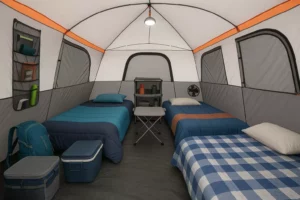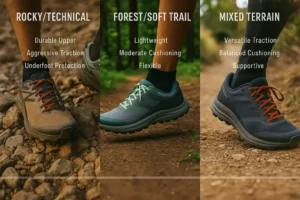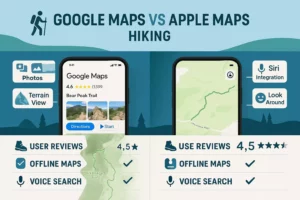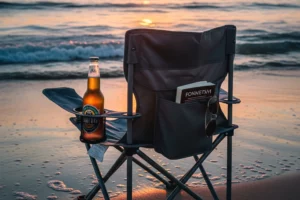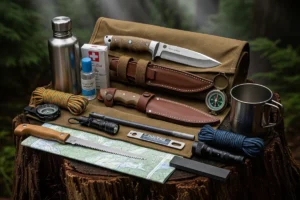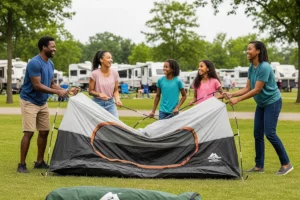How To Pick A Sleeping Bag Camping: The Ultimate Guide to Choosing Your Perfect Sleep System
Picture this: You’re miles deep in the wilderness, surrounded by towering pines and the gentle crackle of dying embers from your campfire. The stars paint stories across the midnight sky, but instead of drifting into peaceful slumber, you’re shivering in an inadequate sleeping bag that’s turning your dream camping trip into a sleepless nightmare. Choosing the right sleeping bag can make or break your entire outdoor adventure – and with hundreds of options available in 2025, knowing what to look for has never been more crucial.
Whether you’re planning a summer family camping trip or preparing for a winter backcountry expedition, your sleeping bag serves as your portable bedroom and your primary defense against the elements. The difference between a restful night and a miserable experience often comes down to this single piece of gear.
Key Takeaways

- Temperature rating is your most critical consideration – choose a bag rated 10-15°F below the coldest temperature you expect to encounter
- Insulation type determines performance – down offers superior warmth-to-weight ratio but loses effectiveness when wet, while synthetic insulation performs better in damp conditions
- Shape affects warmth and comfort – mummy bags provide maximum warmth efficiency, while rectangular bags offer more room to move
- Size and weight matter for your camping style – car campers can prioritize comfort, while backpackers need to balance warmth with packability
- Quality construction and materials directly impact durability, comfort, and long-term value
Understanding Sleeping Bag Temperature Ratings 🌡️
Temperature ratings serve as your primary guide for selecting an appropriate sleeping bag, but understanding what these numbers actually mean can save you from uncomfortable nights outdoors.
The Rating System Explained
Most sleeping bags in 2025 use the EN (European Norm) or ISO testing standards, which provide three key temperature ratings:
- Comfort Rating: The temperature at which an average woman can sleep comfortably
- Lower Limit Rating: The temperature at which an average man can sleep comfortably
- Extreme Rating: The minimum temperature for survival (not comfort)
Always choose a bag rated 10-15°F below the coldest temperature you expect to encounter. This buffer accounts for individual variations in cold tolerance, unexpected weather changes, and the reality that laboratory testing doesn’t always match real-world conditions.
Factors That Affect Your Warmth
Your personal “sleep system” extends beyond just the sleeping bag. Consider these variables:
- Your natural cold tolerance and metabolism
- What you wear to bed (base layers can add 5-10°F of warmth)
- Your sleeping pad’s R-value (insulation from ground cold)
- Shelter type and wind protection
- Hydration and nutrition levels
- Fatigue and stress factors
When planning your camping gear setup, remember that your sleeping bag works as part of an integrated system with your tent, sleeping pad, and clothing layers.
Insulation Types: Down vs Synthetic
The eternal debate between down and synthetic insulation continues to evolve as manufacturers develop new technologies and materials in 2025.
Down Insulation: The Warmth Champion
Advantages:
- Superior warmth-to-weight ratio
- Excellent compressibility for packing
- Long-lasting durability with proper care
- Exceptional breathability
Disadvantages:
- Expensive initial investment
- Loses insulating properties when wet
- Longer drying time
- Requires special care and cleaning
Best for: Dry climates, cold weather camping, backpacking where weight matters, and campers willing to invest in long-term gear.
Synthetic Insulation: The Reliable Performer
Advantages:
- Maintains warmth when wet
- Faster drying time
- More affordable pricing
- Easier maintenance and washing
Disadvantages:
- Heavier than equivalent down bags
- Less compressible
- Shorter lifespan
- Can feel less breathable
Best for: Humid climates, wet conditions, budget-conscious campers, and those wanting low-maintenance gear.
Hybrid Options
Many 2025 sleeping bags combine both insulation types, using down in areas less likely to get wet (top panels) and synthetic insulation in moisture-prone zones (footbox and bottom).
Sleeping Bag Shapes and Sizes
The shape of your sleeping bag significantly impacts both warmth efficiency and sleeping comfort.
Mummy Bags: Maximum Efficiency
Mummy-style bags follow your body’s contours closely, minimizing dead air space that your body must heat.
Pros:
- Most thermally efficient design
- Lightest weight option
- Best for cold weather
Cons:
- Can feel restrictive
- Less room for movement
- May cause claustrophobia
Rectangular Bags: Comfort First
Rectangular bags offer a more traditional blanket-like feel with room to move around.
Pros:
- More spacious and comfortable
- Can fully unzip to use as blanket
- Better for side sleepers
- Often more affordable
Cons:
- Less thermally efficient
- Heavier and bulkier
- Not ideal for cold conditions
Semi-Rectangular: The Compromise
These bags offer a middle ground, providing more room than mummy bags while maintaining better thermal efficiency than rectangular designs.
Size Considerations for Different Body Types
Proper sizing ensures both comfort and thermal efficiency. A bag that’s too large creates excess space your body must heat, while one that’s too small can compress insulation and restrict movement.
Length Sizing
- Regular: Fits most people up to 6 feet tall
- Long: Designed for people 6’2″ and taller
- Women’s Specific: Often shorter torso, wider hips, extra insulation in foot area
Width Considerations
- Narrow/Slim: For smaller builds or maximum warmth
- Regular: Standard fit for average body types
- Wide: Extra room for larger builds or restless sleepers
Weight and Packability for Different Camping Styles
Your camping style should heavily influence your sleeping bag choice, particularly regarding weight and packed size.
Car Camping Priorities
When weight isn’t a concern, prioritize:
- Comfort over weight savings
- Durability for frequent use
- Easy care and maintenance
- Value for money
Backpacking Considerations
Every ounce matters when you’re carrying your gear:
- Weight-to-warmth ratio
- Compressibility (how small it packs)
- Durability under compression
- Multi-use potential
When packing your backpack for camping, your sleeping bag typically represents one of your heaviest and bulkiest items, making the right choice crucial for overall pack weight management.
Special Features and Construction Details
Modern sleeping bags incorporate numerous features that can enhance comfort and functionality.
Zipper Systems
- Full-length zippers: Maximum ventilation control
- Half-length zippers: Weight savings with adequate venting
- Two-way zippers: Foot venting without losing upper body warmth
- Anti-snag designs: Prevent frustrating zipper failures
Hood and Collar Design
- Adjustable hoods: Critical for head warmth retention
- Draft collars: Prevent warm air from escaping around neck
- Pillow pockets: Built-in space for pillow or clothing
Internal Features
- Interior pockets: Store small items like phone or headlamp
- Hang loops: For airing out or storage
- Compression straps: Reduce packed size
🏕️ Sleeping Bag Selector Tool
What type of camping will you primarily do?
What’s the coldest temperature you expect to encounter?
What’s your budget range?
Do you typically sleep hot or cold?
Your Personalized Recommendation:
Budget Considerations and Value Assessment
Sleeping bags represent a significant investment, with prices ranging from under $50 to over $800 in 2025. Understanding what drives these price differences helps you make informed decisions.
Budget Range Breakdown
Entry Level ($50-$150)
- Synthetic insulation
- Basic construction
- Heavier weights
- Limited features
- Good for occasional use
Mid-Range ($150-$400)
- Quality synthetic or entry-level down
- Better construction and materials
- Reasonable weight
- Some premium features
- Suitable for regular camping
Premium ($400-$800+)
- High-quality down insulation
- Advanced materials and construction
- Ultralight options available
- Comprehensive feature sets
- Built for serious outdoor enthusiasts
Calculating Cost Per Use
Consider your camping frequency when evaluating price:
- Occasional campers (1-5 trips/year): Focus on value and versatility
- Regular campers (6-15 trips/year): Invest in quality and comfort
- Frequent adventurers (15+ trips/year): Premium gear pays for itself
Care and Maintenance for Longevity

Proper care significantly extends your sleeping bag’s lifespan and maintains its performance.
Storage Best Practices
- Never store compressed – use a large cotton storage sack
- Keep in cool, dry location away from direct sunlight
- Ensure completely dry before long-term storage
- Periodic airing prevents odor and moisture buildup
Cleaning Guidelines
Down Sleeping Bags:
- Wash only when necessary (every 20-30 uses)
- Use down-specific detergent
- Front-loading washing machine only
- Dry with tennis balls to restore loft
Synthetic Sleeping Bags:
- More frequent washing acceptable
- Regular mild detergent works
- Machine washable and dryable
- Faster drying time
Field Care Tips
- Use a liner to reduce washing frequency
- Air out daily when possible during multi-day trips
- Spot clean minor stains immediately
- Protect from moisture with proper storage
When preparing for extended camping trips, having the right first aid kit and survival gear becomes just as important as your sleep system for overall safety and comfort.
Seasonal Considerations and Multi-Bag Systems
Serious campers often develop a collection of sleeping bags optimized for different conditions rather than relying on one “do-everything” bag.
Summer Camping (50°F+)
- Lightweight synthetic or down
- Minimal features needed
- Focus on ventilation options
- Can double as blanket
Three-Season Use (20°F to 50°F)
- Versatile temperature range
- Quality insulation important
- Balance of warmth and weight
- Most popular category
Winter Camping (Below 20°F)
- Premium insulation required
- Full feature set essential
- Weight less critical than warmth
- Specialized construction needed
Building a System
Many experienced campers use a layering approach:
- Summer bag for warm conditions
- Liner for added warmth (5-15°F boost)
- Winter bag for extreme conditions
- Quilt system for ultralight backpacking
Special Considerations for Different Demographics
Women’s Specific Sleeping Bags
Women’s bags aren’t just smaller versions of men’s bags. They feature:
- Different proportions (shorter torso, wider hips)
- Extra insulation in foot and torso areas
- Warmer temperature ratings for equivalent comfort
- Smaller packed sizes for easier handling
Kids and Family Camping
When camping with kids, consider:
- Growth room in sizing
- Durability for rough handling
- Easy-use zippers for independence
- Fun colors and patterns for engagement
- Safety features like glow-in-the-dark zipper pulls
Tall and Large Body Types
Special considerations include:
- Long and extra-long options for height
- Wide cuts for broader builds
- Extended foot boxes for larger feet
- Reinforced stress points for durability
Common Mistakes to Avoid
Learning from others’ mistakes can save you discomfort and money:
Sizing Errors
- Buying too large thinking more room equals more comfort
- Ignoring length requirements for tall individuals
- Not considering layering space for cold weather
Temperature Rating Misunderstanding
- Taking ratings at face value without personal adjustment
- Ignoring your sleep temperature tendencies
- Forgetting about sleeping pad insulation
Feature Oversights
- Neglecting zipper quality and design
- Overlooking compression and packed size
- Ignoring care and maintenance requirements
Budget Mistakes
- Buying cheap for frequent use (false economy)
- Overspending on occasional-use gear
- Not factoring in accessories (liner, pillow, etc.)
Testing and Final Selection Process

Before making your final purchase, consider these evaluation steps:
In-Store Testing
- Lie down in the bag if possible
- Test zipper operation and smoothness
- Check construction quality at stress points
- Feel insulation distribution for even coverage
- Compare packed sizes if considering multiple options
Research and Reviews
- Read user reviews from verified purchasers
- Check professional gear reviews from outdoor magazines
- Compare specifications across similar models
- Verify warranty terms and customer service reputation
Return Policies
- Understand return windows for unused gear
- Check condition requirements for returns
- Save all packaging until you’re certain
- Test at home before your first trip
Accessories and Sleep System Integration
Your sleeping bag works best as part of an integrated sleep system:
Essential Accessories
- Sleeping pad with appropriate R-value for insulation
- Pillow or inflatable pillow for comfort
- Liner for cleanliness and extra warmth
- Compression sack for packing (if not included)
Optional Enhancements
- Sleeping bag cover for added weather protection
- Camp blanket for extra warmth in extreme conditions
- Pillow case for hygiene and comfort
- Repair kit for field fixes
Clothing Considerations
What you wear to bed significantly impacts your sleep system performance. Cool weather clothes for camping should include appropriate base layers that work with your sleeping bag rather than against it.
Environmental and Sustainability Factors
In 2025, environmental consciousness increasingly influences gear purchasing decisions:
Sustainable Materials
- Recycled synthetic insulation from plastic bottles
- Responsibly sourced down with ethical certifications
- Bluesign approved fabrics for environmental safety
- PFC-free DWR treatments for water resistance
Durability as Sustainability
- Quality construction reduces replacement frequency
- Repairable designs extend useful life
- Modular systems allow component upgrades
- Take-back programs from some manufacturers
End-of-Life Considerations
- Recycling programs for worn-out gear
- Donation opportunities for usable equipment
- Repurposing possibilities for damaged bags
- Manufacturer take-back initiatives
Conclusion
Selecting the perfect sleeping bag requires balancing multiple factors: temperature requirements, insulation type, shape preferences, weight considerations, and budget constraints. The key lies in honestly assessing your camping style, frequency of use, and personal comfort preferences before making this important investment.
Remember that the “best” sleeping bag is the one that matches your specific needs, not necessarily the most expensive or feature-laden option. Whether you’re planning family camping activities or preparing for solo wilderness adventures, your sleeping bag serves as the foundation of comfortable outdoor rest.
Take action today by using the interactive tool above to narrow down your options, then visit local outdoor retailers to test bags in person. Consider starting with a versatile three-season bag if you’re new to camping, as it provides the best balance of utility and value for most outdoor enthusiasts.
Your perfect night’s sleep under the stars awaits – and it starts with choosing the right sleeping bag for your adventures. Don’t let inadequate gear rob you of the restorative power of sleeping in nature. Invest in quality sleep gear, and every camping trip becomes an opportunity for true rest and rejuvenation in the great outdoors.

